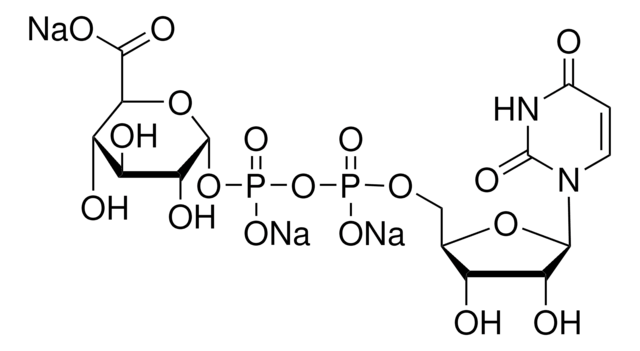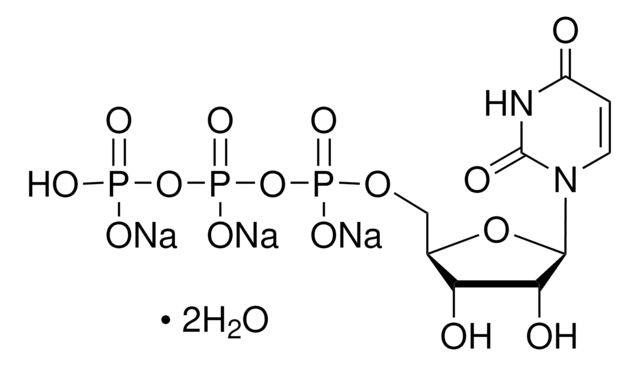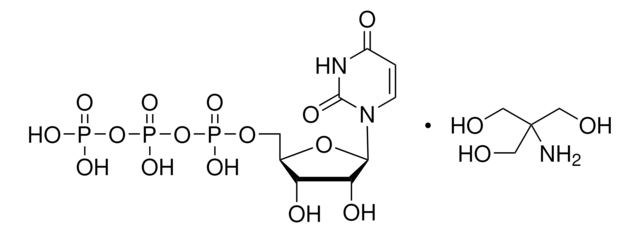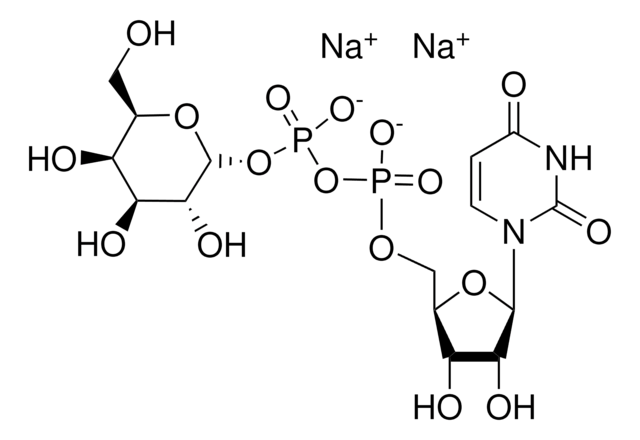94330
Uridine 5′-diphosphate disodium salt hydrate
≥96.0% (HPLC)
동의어(들):
UDP, 5′-UDP-Na2
로그인조직 및 계약 가격 보기
모든 사진(1)
About This Item
실험식(Hill 표기법):
C9H12N2Na2O12P2 · xH2O
CAS Number:
Molecular Weight:
448.12 (anhydrous basis)
Beilstein:
8817400
EC Number:
MDL number:
UNSPSC 코드:
41106305
PubChem Substance ID:
NACRES:
NA.51
추천 제품
생물학적 소스
synthetic
Quality Level
분석
≥96.0% (HPLC)
형태
powder
불순물
≤15% water
저장 온도
−20°C
SMILES string
[Na+].[Na+].[H]O[H].O[C@H]1[C@@H](O)[C@@H](O[C@@H]1COP([O-])(=O)OP(O)([O-])=O)N2C=CC(=O)NC2=O
InChI
1S/C9H14N2O12P2.2Na.H2O/c12-5-1-2-11(9(15)10-5)8-7(14)6(13)4(22-8)3-21-25(19,20)23-24(16,17)18;;;/h1-2,4,6-8,13-14H,3H2,(H,19,20)(H,10,12,15)(H2,16,17,18);;;1H2/q;2*+1;/p-2/t4-,6-,7-,8-;;;/m1.../s1
InChI key
RHBXRWOXLRCWIZ-LLWADOMFSA-L
애플리케이션
Uridine 5′-diphosphate disodium salt hydrate has been used:
- as a standard for quantification of metabolite levels in murine tumor interstitial fluid by liquid chromatography-mass spectrometry (LC/MS)
- as a UDP standard for nucleotide analysis by liquid chromatography-high resolution mass spectrometry (LC-HRMS)
- to treat E6.5 retina explants in vitro, to study its effect on the entry and elongation of microglial cells into the embryonic quail retina
생화학적/생리학적 작용
Uridine 5′-diphosphate (UDP) is an endogenous signaling molecule produced by damaged cells to attract macrophages. In response to neuronal damage, UDP promotes chemotaxis and chemokinesis in microglial cells. UDP serves as a ligand for P2Y receptors. UDP and uridine 5′-triphosphate (UTP) may be used in studies on nucleic acid (RNA) biosynthesis and cell signaling. UDP is a nucleotide that upon phosphorylation to UTP becomes a substrate for enzymes such as RNA polymerase(s) and GTPases. These enzymes are involved in a wide range of applications from the synthesis of RNA to the regulation of G-coupled protein receptors (GPCR) and cell signaling molecules such as Rho-signaling via guanine nucleotide exchange factors (GEF).
신호어
Warning
유해 및 위험 성명서
Hazard Classifications
Eye Irrit. 2 - Skin Irrit. 2 - STOT SE 3
표적 기관
Respiratory system
Storage Class Code
11 - Combustible Solids
WGK
WGK 3
Flash Point (°F)
Not applicable
Flash Point (°C)
Not applicable
개인 보호 장비
dust mask type N95 (US), Eyeshields, Gloves
시험 성적서(COA)
제품의 로트/배치 번호를 입력하여 시험 성적서(COA)을 검색하십시오. 로트 및 배치 번호는 제품 라벨에 있는 ‘로트’ 또는 ‘배치’라는 용어 뒤에서 찾을 수 있습니다.
이미 열람한 고객
Kenneth A Jacobson et al.
Purinergic signalling, 5(1), 75-89 (2008-07-05)
Although elucidation of the medicinal chemistry of agonists and antagonists of the P2Y receptors has lagged behind that of many other members of group A G protein-coupled receptors, detailed qualitative and quantitative structure-activity relationships (SARs) were recently constructed for several
María Martín-Estebané et al.
PloS one, 12(8), e0182450-e0182450 (2017-08-02)
Microglial cell precursors located in the area of the base of the pecten and the optic nerve head (BP/ONH) start to enter the retina of quail embryos at the 7th day of incubation (E7), subsequently colonizing the entire retina by
Feng Ding et al.
Current topics in medicinal chemistry, 11(23), 2879-2887 (2011-08-10)
The Rho family small GTPases of the Ras superfamily play key roles in regulating diverse signaling pathways that control a myriad of fundamental cellular processes such as cytoskeletal dynamics, cell cycle progression, gene expression, cell polarity, migration and cell transformation.
Caroline Liot et al.
PloS one, 6(8), e23676-e23676 (2011-09-03)
Besides regulation of actin cytoskeleton-dependent functions, Rho GTPase pathways are essential to cell cycle progression and cell division. Rho, Rac and Cdc42 regulate G1 to S phase progression and are involved in cytokinesis. RhoA GDP/GTP cycling is required for normal
Sara J Wright et al.
Genetics, 189(1), 165-176 (2011-07-14)
Heterotrimeric (αβγ) G proteins are crucial components of eukaryotic signal transduction pathways. G-protein-coupled receptors (GPCRs) act as guanine nucleotide exchange factors (GEFs) for Gα subunits. Recently, facilitated GDP/GTP exchange by non-GPCR GEFs, such as RIC8, has emerged as an important
자사의 과학자팀은 생명 과학, 재료 과학, 화학 합성, 크로마토그래피, 분석 및 기타 많은 영역을 포함한 모든 과학 분야에 경험이 있습니다..
고객지원팀으로 연락바랍니다.












